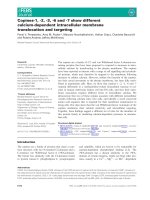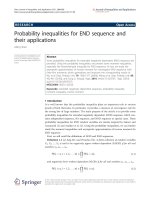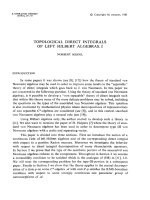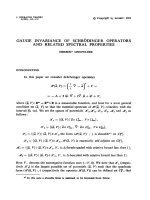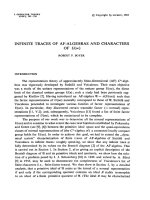Báo cáo toán học: "Composition matrices, (2 + 2)-free posets and their specializations" doc
Bạn đang xem bản rút gọn của tài liệu. Xem và tải ngay bản đầy đủ của tài liệu tại đây (173.52 KB, 9 trang )
Composition matrices, (2 + 2)-free posets and their
specializations
Mark Dukes
∗
Department of Computer and Information Sciences
University of Strathclyde, Glasgow, UK
V´ıt Jel´ınek
Fakult¨at f¨ur Mathematik, Universit¨at Wien
Nordbergstraße 15, A-1090 Vienna, Austria
Martina Kubitzke
Fakult¨at f¨ur Mathematik, Universit¨at Wien
Nordbergstraße 15, A-1090 Vienna, Austria
Submitted: Oct 6, 2010; Accepted: Feb 7, 2011; Published: Feb 21, 2011
Mathematics Subject Classification: 05A19, 06A07
Abstract
In this paper we present a bijection between composition matrices and (2 + 2)-
free posets. This bijection maps partition matrices to factorial posets, and induces a
bijection from upper triangular matrices with non-negative entries having no rows or
columns of zeros to unlabeled (2 + 2)-free posets. Chains in a (2 + 2)-free poset are
shown to correspond to entries in the associated composition matrix whose hooks
satisfy a simple condition. It is shown that the action of taking the dual of a poset
corresponds to reflecting the associated composition matrix in its anti-diagonal. We
further characterize posets which are both (2 + 2)- and (3 + 1)-free by certain prop-
erties of their associated composition matrices.
Keywords: (2+2)-free poset; interval orders; composition matrix; dual poset; bi-
jection
∗
All authors were supported by grant no. 090038012 from the Icelandic Research Fund.
the electronic journal of combinatorics 18 (2011), #P44 1
Ascent sequences
× set partitions
Labeled (2 + 2)-
free posets
Composition
matrices
[3] [3]
Ascent
sequences
Unlabeled
(2 + 2)-
free posets
Integer
matrices
[5] [2]
Inversion
sequences
Factorial
posets
Partition
matrices
[3] [4]
Figure 1: Overview of known correspondences.
References
[1] K. P. Bogart. An obvious proof of Fishburn’s interval order theorem. Discrete Math-
ematics 118 (1993), no. 1–3, 239–242.
[2] M. Bousquet-M´elou, A. Claesson, M. Dukes and S. Kitaev. (2 + 2)-free posets, as-
cent sequences and pattern avoiding permutations. Journal of Combinatorial Theory
Series A 117 (2010), no. 7, 884–909.
[3] A. Claesson, M. Dukes and M. Kubitzke. Partition and composition matrices.
Journal of Combinatorial Theory Series A, to appear (2011).
[4] A. Claesson and S. Linusson. n! matchings, n! posets. Proceedings of the American
Mathematical Society 139 (2011), 435–449
[5] M. Dukes and R. Parviainen. Ascent sequences and upper triangular matrices
containing non-negative integers. Electronic Journal of Combinatorics 17 (2010), no.
1, R53 (16pp).
[6] P. C. Fishburn. Interval orders and interval graphs. John Wiley & Sons, Ltd., Chich-
ester, 1985.
[7] M. Skandera. A Characterization of (3 + 1)-Free Posets. Journal of Combinatorial
Theory Series A 93 (2001), no. 2, 231–241.
[8] R. P. Stanley. Enumerative Combinatorics Volume 1. Cambridge University Press,
1997.
the electronic journal of combinatorics 16 (2009), #R00 1
Figure 1: Overview of known correspondences.
1 Introduction
The recent introduction of bivincular patterns has unearthed surprising new connections
between several combinatorial objects. Relaxing some parts of the definitions of these
objects led to yet more new connections between supersets of these structures. Figure 1
summarizes the correspondences between three of these objects (at three different levels).
Black lines indicate that a bijection has been proven and the label on a line indicates the
paper in which this has been achieved. A dashed line indicates that no direct bijection
between the corresponding objects is known.
This paper completes these pictures by presenting and proving bijections for the dashed
lines. We do this first at the ‘highest’ level, namely mapping labelled (2 + 2)-free posets
to composition matrices. We then show that restrictions of this general map bijections
from unlabeled (2 + 2)-free posets to integer matrices, and from factorial posets to par-
tition matrices. The bijection we present here is much simpler and more direct than the
previously known bijections involving ascent sequences [2, 3, 5], which are defined recur-
sively using case distinctions. In particular, our description of the correspondence between
posets and matrices is simpler than a description obtained by mechanical composition of
previously known bijections, which allows us to point out some additional properties of
this correspondence. For instance, we show that the composition matrices of a poset and
its dual are related by transposition along the anti-diagonal, and that the (2 + 2)- and
(3 + 1)-free posets (also known as semiorders) correspond precisely to matrices avoiding
a north-east chain of length 2.
For the special case of unlabeled (2 + 2)-free posets with no indistinguishable elements,
our correspondence between posets and matrices coincides with the long-known notion of
the electronic journal of combinatorics 18 (2011), #P44 2
characteristic matrix of an interval order, introduced by Fishburn [6, Chpt. 2]. Although
Fishburn’s original definition is different from ours, it is easy to check that they are indeed
equivalent.
2 (2 + 2)-free posets and composition matrices
In this section we present and prove a bijection between (2 + 2)-free posets and compo-
sition matrices.
We call an upper triangular matrix M a composition matrix on the set [n] = {1, . . . , n}
if the entries of M are subsets of [n], where all the non-empty entries form a partition of
[n]. and there are no rows or columns that contain only empty sets. Let M
n
be the set of
composition matrices on [n ].
A partially ordered set P = (P,
P
) is called (2 + 2)-free if it contains no induced
subposet that is isomorphic to 2 + 2, the union of two disjoint 2-element chains. An
equivalent characterization of (2 + 2)-free posets is the following [1]: a poset (P,
P
) is
(2 + 2)-free if and only if the set of downsets {D(x)}
x∈P
may be linearly ordered by
inclusion. Here, for an element x ∈ P , the set D(x) = {y ∈ P : y ≺
P
x} denotes the
downset of x. For the purposes of this paper, and without loss of generality, we will always
assume that as a set P equals [n]. Let P
n
be the collection of (2 + 2)-free posets with
labels in the set [n].
Throughout this paper, when there is no confusion about the poset in question, we
will replace
P
with and so forth.
In order to discuss (2 + 2)-free posets more precis ely, we will make use of the following
definitions.
Suppose P = ([n], ) ∈ P
n
. If |{D(x) : x ∈ P }| = m + 1 then we will write d(P ) = m.
Let D(P ) = (D
0
, . . . , D
d(P )
) be the sequence of different downsets of P, linearly ordered
by inclusion, i.e., ∅ = D
0
· · · D
d(P )
. An element x ∈ P with D(x) = D
i
for a certain
i will be said to lie on level i of P. We use L
i
= L
i
(P ) to denote the s et of elements on
level i of P , and set L(P ) = (L
0
, . . . , L
d(P )
). The sequence L(P ) will be referred to as the
level sequence of P . Note that every poset P ∈ P
n
is uniquely described by listing the
sequences D(P ) and L(P ).
Define D
d(P )+1
:= [n] and set K
j
:= D
j+1
\D
j
for all 0 ≤ j ≤ d(P ).
Definition 1. Given (P, ) ∈ P
n
. Let M = Γ(P ) be the (d(P ) + 1) × (d(P ) + 1)-matrix
over the powerset of [n] where the entry in the i
th
row and j
th
column of M is given as
M
ij
:= L
i−1
∩ K
j−1
for all 1 ≤ i, j ≤ d(P ) + 1.
Example 2. Let P = ([8], ) ∈ P
8
with the following relations: 4, 8 ≺ 2; 3, 4, 8 ≺
5 ≺ 7 ≺ 1, 6. There are five different downsets: D
0
= ∅, D
1
= {4, 8}, D
2
= {3, 4, 8},
D
3
= {3, 4, 5, 8}, and D
4
= {3, 4, 5, 7, 8}. From these we form the sets K
0
= {4, 8},
K
1
= {3}, K
2
= {5}, K
3
= {7}, and K
4
= {1, 2, 6}. The elements on each level are
the electronic journal of combinatorics 18 (2011), #P44 3
L
0
= {3, 4, 8}, L
1
= {2}, L
2
= {5}, L
3
= {7}, and L
4
= {1, 6}. From this we get
M = Γ(P ) =
{4, 8} {3} ∅ ∅ ∅
∅ ∅ ∅ ∅ {2}
∅ ∅ {5} ∅ ∅
∅ ∅ ∅ {7} ∅
∅ ∅ ∅ ∅ {1, 6}
.
Note that the matrix Γ(P ) which was constructed in the above example is a compo-
sition matrix on [8]. This is no coincidence and turns out to be true in general.
Lemma 3. Let P ∈ P
n
. Then Γ(P ) ∈ M
n
.
Proof. Let P = ([n], ) ∈ P
n
and set M = Γ(P ). The union of the elements in the
(i + 1)
st
row of M is L
i
. Since the set L
i
is always non-empty, it follows that the (i + 1)
st
row cannot consist of only empty sets. The union of the elements in the (j + 1)
st
column
of M is K
j
. Since every non-trivial poset contains at least one maximal element, K
d(P )
is
non-empty. For j < d(P ) it holds that D
j
D
j+1
which implies that K
j
= D
j+1
\D
j
is
non-empty. Hence each column of M contains at least one non-empty set.
It remains to show that the entries of M partition the set [n] which is the case if and
only if every element x ∈ [n] appears in exactly one entry of M. Since both {L
i
} and
{K
i
} are partitions of the set [n], it follows that no two rows (or columns) have common
elements. This implies that all the non-empty entries form a partition of [n].
Suppose that x ∈ D
j
for some j. Then x cannot b e above level j − 1 in P, i.e. x ∈
L
j
, L
j+1
, . . This means that the sets L
i
∩D
j
= ∅ for all i ≥ j =⇒ L
i
∩K
j
= M
i+1,j
= ∅
for all i ≥ j, giving us that M = Γ(P ) is upper triangular. Thus M = Γ(P ) ∈ M
n
.
Definition 4. Let R
n
= {(i, j) : 1 ≤ i ≤ j ≤ n}. Given (i, j), (i
, j
) ∈ R
n
let us write
(i, j) (i
, j
) if j < i
. This is equivalent to the ‘hook’ between both entries having its
bottom-left corner below the main diagonal:
j
j
i
i
Lemma 5. Let P ∈ P
n
and M = Γ(P ). Suppose that x, y ∈ P with x ∈ M
ij
and y ∈ M
i
j
.
Then x ≺ y if and only if (i, j) (i
, j
).
Proof. Let P = ([n], ) ∈ P
n
, d(P ) = m and M = Γ(P ). We have the two sequences of
sets associated with P ;
L(P ) = (L
0
, L
1
, . . . , L
m
) and D(P ) = (D
0
, D
1
, . . . , D
m
).
Since x ∈ M
ij
= (D
j
\ D
j−1
) ∩ L
i−1
we have x ∈ D
r
iff r ≥ j. On the other hand
y ∈ M
i
j
= (D
j
\ D
j
−1
) ∩ L
i
−1
, i.e., y is on level i
− 1 and thus D(y) = D
i
−1
. Finally,
x ≺ y ⇐⇒ x ∈ D(y) = D
i
−1
⇐⇒ i
− 1 ≥ j, that is, x y.
the electronic journal of combinatorics 18 (2011), #P44 4
For M ∈ M
n
and x ∈ [n], if x ∈ M
ij
we use ζ(x) = ζ
M
(x) = (i, j) to denote the
position in which x occurs in M.
Definition 6. Let M ∈ M
n
be an (m + 1) × (m + 1) composition matrix. Define a poset
Φ(M) = ([n], ) as follows: for x, y ∈ [n], let x ≺ y if and only if ζ
M
(x) ζ
M
(y).
It is clear that Φ(M) is indeed a poset. Our goal is to show that the mapping Φ is the
inverse of Γ.
Example 7. Let M be the matrix
{5} ∅ {3, 6} ∅
∅ {1, 8, 9} ∅ ∅
∅ ∅ ∅ {4, 7}
∅ ∅ ∅ {2}
.
This gives the poset P = Φ(M) on [9] with order relations:
5 ≺ 1, 8, 9 ≺ 2, 4, 7; 3, 6 ≺ 2.
In analogy to the notion of downset it is common to consider the so-called upset of an
element x ∈ P . More precisely, if (P, ) is a poset and x ∈ P then U(x) := {y ∈ P | y x}
is referred to as the upset of x. Elements x, y ∈ P are called indistinguishable if they have
the same downsets and upsets, i.e., D(x) = D(y) and U (x) = U (y ).
Upsets and downsets of the poset Φ(M) can be easily described in terms of the ma-
trix M , as shown in the next le mma.
Lemma 8. Let M ∈ M
n
be a composition matrix with m rows. Let R
i
⊆ [n] be the union
of the cells in the i-th row of M, and let C
j
be the union of the cells in its j-th column.
Let D(x) and U(x) denote the downset and upset of an element x in the poset Φ(M). The
following holds.
• For x ∈ M
ij
, we have D(x) =
i−1
k=1
C
k
and U(x) =
m
k=j+1
R
k
.
• For two elements x, y ∈ [n], we have D (x) = D(y) iff x and y appear in the same
row of M, and U(x) = U (y) iff x and y appear in the same column.
• Two elements x, y ∈ [n] are indistinguishable in Φ(M) iff they belong to the same
cell of M.
• The poset Φ(M ) is (2 + 2)-free.
Proof. The first claim follows directly from the definition of Φ. The second claim is a
consequence of the first one, together with the fact that every row and every column of
M has at least one nonempty cell. The third claim is an immediate consequence of the
second one. Finally, to prove the fourth claim, we first observe that the first claim of
the lemma implies that any two downsets of Φ(M) are comparable by inclusion. A poset
whose downsets are linearly ordered by inclusion is (2 + 2)-free.
the electronic journal of combinatorics 18 (2011), #P44 5
Theorem 9. Γ : P
n
→ M
n
is a bijection and Φ is its inverse.
Proof. Lemma 5 shows that Φ(Γ(P )) = P for any P ∈ P
n
. It remains to verify that
Φ is injective. Let M ∈ M
n
be a composition matrix, with R
i
and C
j
defined as in
Lemma 8. Let P = Φ(M). From Lemma 8, we see that the number of rows of M
is equal to the number of distinct downsets in P . Suppose that P has m + 1 distinct
downsets D
0
⊂ D
1
⊂ · · · ⊂ D
m
, and define D
m+1
= [n]. Lemma 8 then implies that
C
j
= D
j
\ D
j−1
for any j ∈ [m + 1]. Similarly, the sets R
i
are determined by the upsets
of P . Since the matrix M can be uniquely reconstructed from the sets {R
i
; i ∈ [m + 1]}
and {C
j
; j ∈ [m+1]}, we conclude that P determines M uniquely, hence Φ is injective.
For any poset P let P
be the dual of P , i.e., P
is defined by the equivalence x ≺
P
y ⇐⇒ y ≺
P
x.
Given an (a × a)-matrix M, let trans(M ) be the matrix defined by
trans(M)
ij
= M
a+1−j,a+1−i
.
The matrix trans(M) is obtained by reflecting M in its anti-diagonal and we call trans(M )
the anti-transpose of M .
We conclude this section by pointing out that poset duality corresponds to matrix
anti-transpose.
Theorem 10. Let P ∈ P
n
and M = Γ(P ). Then Γ(P
) = trans(M).
Proof. From the definition of Φ, we immediately see that for any M ∈ M
n
, Φ(trans(M ))
is the dual of the poset Φ(M ). Since Γ is the inverse of Φ, the theorem follows.
3 Special classes of (2 + 2)-free posets
3.1 Unlabeled (2 + 2)-free posets
Let P ∈ P
n
be a poset, let M ∈ M
n
be a composition matrix and let π : [n] → [n] be a
permutation. Define π(P ) to be the poset obtained from P by replacing each label i with
the label π(i) and let π(M ) to be the matrix obtained from M by changing each value i
into π(i). Notice that π(Γ(P )) = Γ(π(P )).
We say that two posets P, Q ∈ P
n
are isomorphic, denoted by P ∼ Q, if there is a
permutation π such that Q = π(P ). Let [P ] denote the isomorphism class of a poset
P ∈ P
n
. Let U
n
be the set of equivalence classes of posets from P
n
. The elements of U
n
are often referred to as unlabeled (2 + 2)-free posets.
Let card(M) be the integer matrix whose the entry at a position (i, j) is equal to the
cardinality of the set M
ij
.
Lemma 11. Let P, Q ∈ P
n
. Then P ∼ Q iff card(Γ(P )) = card(Γ(Q)).
the electronic journal of combinatorics 18 (2011), #P44 6
Proof. If P ∼ Q then there exists a permutation π : [n] → [n] such that P = π(Q).
This implies that card(Γ(P )) = card(Γ(π(Q))) = card(π(Γ(Q))). Since π only changes the
entries of the sets in Γ(Q), and not their cardinality, we have card(π(Γ(Q))) = card(Γ(Q)).
Hence card(Γ(P )) = card(Γ(Q)).
Conversely, if card(Γ(P )) = card(Γ(Q)) then there exists a permutation σ : [n] → [n]
such that Γ(P ) = σ(Γ(Q)) = Γ(σ(Q)). Since by Theorem 9 Γ is a bijection we obtain
P = σ(Q) which implies P ∼ Q.
Let Int
n
be the set of upper triangular matrices whose entries are non-negative integers
having the property that the matrix contains no row or column of all zero entries and
the sum of all entries equals n. Note that a matrix N belongs to Int
n
if and only if
N = card(M) for some M ∈ M
n
.
Let us note that by looking at equivalence classes we have gotten rid of the labeling
of posets and we have exactly one equivalence class for each unlabeled poset on [n]. We
now set Γ
([P ]) = card(Γ(P )). The map Γ
should be thought of as the restriction of the
previously used map Γ to unlabeled posets on [n].
Theorem 12. Γ
: U
n
→ Int
n
is a bijection.
Proof. It is clear that Γ
is surjective, because for every N ∈ Int
n
, there is a composition
matrix M ∈ M
n
such that N = card(M ), and the corresponding poset P = Φ(M) then
satisfies Γ
([P ]) = N.
Let us verify that Γ
is injective. Given two unlabeled posets [P ], [Q] ∈ U
n
, we see
that Γ
([P ]) = Γ
([Q]) iff card(Γ(P )) = card(Γ(Q)) iff P ∼ Q, by Lemma 11. Hence
[P ] = [Q].
Let us remark that our bijections Γ and Γ
provide the same mapping from posets to
matrices as the bijections obtained by composing previously known bijections from posets
to special kinds of integer sequences [2, 3] and from integer sequences to matrices [3, 5].
3.2 Factori al posets and partition matrices
Let P = ([n],
P
) ∈ P
n
. Let FP
n
be the collection of factorial posets in P
n
, where a poset
P ∈ P
n
is factorial if for all i, j, k ∈ [n],
i < j ≺
P
k =⇒ i ≺
P
k.
Here < denotes the usual order relation on N. These posets were intro duce d by Claesson
and Linusson in [4]. An equivalent definition of factorial posets is the following:
Definition 13. Let P ∈ P
n
with d(P ) = m. The poset P is factorial iff there exist
integers 1 ≤ a
1
< · · · < a
m
< n such that D
i
(P ) = [1, a
i
] for all 1 ≤ i ≤ m.
Given M ∈ M
n
and x ∈ [n], let col (x) denote the index of the column of M in which
x appears. Following [3] we call M a partition matrix if col(x) < col(y) =⇒ x < y. Let
PM
n
be the set of partition matrices in M
n
.
Restricting the map Γ to factorial posets we obtain the following res ult.
the electronic journal of combinatorics 18 (2011), #P44 7
Theorem 14. A poset P ∈ P
n
is a factorial poset if and only the matrix Γ(P ) is a
partition matrix. In other words, Γ can be restricted to a bijection from FP
n
to PM
n
.
Proof. Suppose that P is a factorial poset, and let M = Γ(P ). Choose x, y ∈ [n] such
that col(x) < col(y). Lemma 8 implies that P has a downset that contains x but not y.
Since P is factorial, each of its downsets has the form {1, 2, . . . , a
i
} for some a
i
. This
means that x < y and hence M ∈ PM
n
. The converse implication can be verified by an
analogous argument.
3.3 (2 + 2) and (3 + 1)-free posets
The posets we consider in this subsection are labeled. A poset P is (3 + 1)-free if it
contains no induced subposet that is isomorphic to 3 + 1, the disjoint union of a 3-
element chain and a singleton. Posets that are (3 + 1)-free have been studied by several
people (see for example Skandera [7]). Posets that are both (2 + 2)- and (3 + 1)-free
are also called semiorders. The condition for an interval order to be (3 + 1)-free is that
its intervals are all of the same length. In this section we characterize posets which are
(2 + 2)- and (3 + 1)-free in terms of their associated upper triangular matrices.
Lemma 15. Let P ∈ P
n
with d(P ) = m and M = Γ(P ). Given x ∈ M
ij
, the set of
elements in P which are incomparable to x are those elements (other than x) that appear
in the following entries of M: {(i
, j
) ∈ R
m+1
: i
≤ j, j
≥ i}.
Proof. This is a consequence of the first part of Lemma 8.
Proposition 16. Let P ∈ P
n
with d(P ) = m and let M = Γ(P ). Then the following
conditions are equivalent:
(i) P contains an induced subposet isomorphic to 3 + 1.
(ii) There exist elements x ∈ M
ij
and y ∈ M
i
j
such that i
< i and j
> j.
Proof. First assume that P contains an induced subposet isomorphic to 3 + 1. Let
x
1
, x
2
, x
3
, x
4
be the elements of this occurrence where x
1
≺ x
2
≺ x
3
is the 3-element
chain. Let ζ(x
k
) = (i
k
, j
k
) for 1 ≤ k ≤ 4. We then have (i
1
, j
1
) (i
2
, j
2
) (i
3
, j
3
).
Since x
1
and x
3
are incomparable to x
4
, we deduce from Lemma 15 that i
4
≤ j
1
and
j
4
≥ i
3
. Also, since i
4
≤ j
1
and (i
1
, j
1
) (i
2
, j
2
) we have i
4
< i
2
. Similarly, j
4
≥ i
3
and
(i
2
, j
2
) (i
3
, j
3
) implies j
4
> j
2
. Thus (ii) is satisfied with x = x
2
and y = x
4
.
Now assume that (ii) holds. Since j
∈ [j + 1, m + 1] and i
∈ [1, i − 1] we have that
y is north-east of x in M. From Lemma 15 we thus have that y is incomparable to x. It
follows from i
< i ≤ j < j
that i
= j, j
and j
= i, i
. Thus neither x nor y are in row
j
or column i
. Let a be an element in column i
of M and let b be an element in row j
of M .
Since the hook of a and y lies on the diagonal, we have the a and y are incomparable.
The elements y and b are incomparable for the same reason. So y is incomparable to
a, x and b. The element a is in column i
of M which means that a ≺ x, since i
< i.
the electronic journal of combinatorics 18 (2011), #P44 8
Similarly the element b is in row j
of M which gives x ≺ b since j < j
. Combining these
observations yields that a ≺ x ≺ b and y is incomparable to a, x and b. Thus P restricted
to the set {a, x, b, y} is isomorphic to 3 + 1, and condition (i) is satisfied.
References
[1] K. P. Bogart. An obvious proof of Fishburn’s interval order theorem. Discrete Math-
ematics 11 8 (1993), no. 1–3, 239–242.
[2] M. Bousquet-M´elou, A. Claesson, M. Dukes and S. Kitaev. (2 + 2)-free posets, as-
cent sequences and pattern avoiding permutations. Journal of Combinatorial Theory
Series A 117 (2010), no. 7, 884–909.
[3] A. Claesson, M. Dukes and M. Kubitzke. Partition and composition matrices.
Journal of Combinatorial Theory Series A, to appear (2011).
[4] A. Claesson and S. Linusson. n! matchings, n! posets. Proceedings of the American
Mathematical Society 139 (2011), 435–449
[5] M. Dukes and R. Parviainen. Ascent sequences and upper triangular matrices
containing non-negative integers. Electronic Journal of Combinatorics 17 (2010), no.
1, R53 (16pp).
[6] P. C. Fishburn. Interval orders and interval graphs. John Wiley & Sons, Ltd., Chich-
ester, 1985.
[7] M. Skandera. A Characterization of (3 + 1)-Free Posets. Journal of Combinatorial
Theory Series A 93 (2001), no. 2, 231–241.
[8] R. P. Stanley. Enumerative Combinatorics Volume 1. Cambridge University Press,
1997.
the electronic journal of combinatorics 18 (2011), #P44 9
